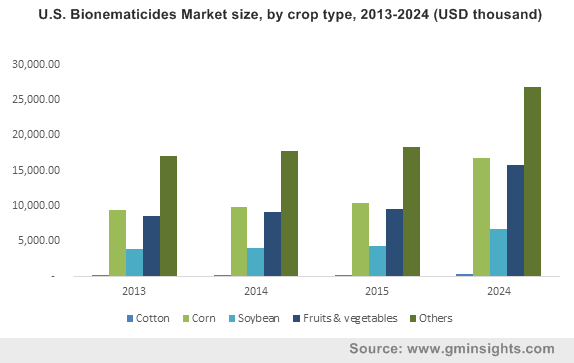Cotton-based bionematicides market to witness lucrative growth over 2016-2024, Asia Pacific to account for highest gains
Publisher : Fractovia | Published Date : 2017-06-09Request Sample
Global bionematicides market is expected to be driven by two prime factors, which include the growing population and rapid industrialization. The arable land is on the verge of deterioration, as the effect of industrialization is resulting in the loss of fertile land and an increase in the environmental pollution. On the other hand, the global population is expected to cross 9 billion by 2050, which has raised questions over the disproportionate food demand-supply graph. Consequently, these adverse scenarios have led to an increase use of fertilizers and other crop yielding products to boost the crop production rate. Bionematicides are basically bio-pesticides which are used to treat and control the growth of nematode infestation on crops. Bionematicides market is set to grow with the rising product demand, owing to its cost effectiveness and the use of natural plants and animal extracts. Strict environmental norms in favor of organic fertilizers and bio-based composts have further increased the demand for bionematicides.
Bionematicides market is gaining traction as it finds extensive usage in crop production, which includes soybeans, corn, cotton, fruits, leafy vegetables, pepper, tomato, etc. Among these, cotton and corn require higher soil fertilization to improve yield. Bionematicides market was valued over USD 800,000 in 2015 due to the increasing product application for growing cotton. As per estimates, bionematicides market size from the corn crop is projected to attain highest growth of 4.5% over 2016-2024, subject to the increase in biological methods to control crop disease. Fruits & vegetables crop segment collected a revenue worth USD 41 million in 2015 and is expected to escalate the demand for bionematicides market. Bionematicides market for soybean is anticipated to exceed USD 14.5 million over 2016-2024. As per a report by Global Market Insights, Inc., the global bionematicides industry is estimated to record a CAGR of 4% over the period of 2016-2024.
U.S. Bionematicides Market size, by crop type, 2013-2024 (USD thousand)

The trade of agricultural commodities is expected to witness a major upswing with rising food demand. The bionematicides industry is expected to help counter the demand-supply gap over the coming years by boosting the crop production. The import of cereals is likely to witness an upsurge of more than three times to reach 300 million tons by 2050, particularly in the regions of Latin America and Sub Saharan Africa. Moreover, the soaring agricultural sector has been an essential factor that has led to a successful economic transformation in the European countries and the USA. The trend is also emerging in many Asian countries which include India, Taiwan, Republic of Korea, Vietnam, and China.
Asia Pacific is a prominent region which exhibits concerns over the rising population and rapid industrialization. Such factors fuel the requirement of higher crop yielding capacity in the region. India, Japan, and China are the key agro-based countries where farming is the basic occupation for sustenance. Asia Pacific bionematicides market collected a revenue of USD 23 million in 2015 and will generate significant revenue with a CAGR of more than 4% over the period of 2016 to 2024. Many prominent governmental organizations are supporting the industry growth by promoting sustainable farming in terms of favorable loans and subsidies, which will stimulate bionematicides industry size considerably over the years ahead.
Regulatory bodies across the globe have also been taking initiation to increase the crop yield. The Department of Environment Toxicology of U.S. is deploying strict norms to increase the crop protection by the usage of bio pesticides. This strict action will lead to growing adoption of bio pesticides across the U.S. In North America, U.S. bionematicides market collected a revenue of USD 42 million in 2015 and will exhibit significant annual growth rate over the years ahead. Shifting trends toward biotechnology based agriculture applications such as yield enhancers and microbe based pest control will boost the product demand noticeably. In addition, major business players have established their corn processing firms across this region on large scale. The United States is notable for producing an extensive yield of fruits, corn, and vegetables, which will influence bionematicides industry size notably.
The top five players of this industry accounted for more than 50% of the global volume of 2015. These companies have been actively participating in research & development activities to develop more sustainable products for agriculture. Key participants in bionematicides market are Dow AgroSciences LLC., Bayer CropScience AG, Monsanto Company, Valent BioSciences Corporation, BASF SE, Syngenta AG, Certis USA LLC., Marrone Bio Innovations, Inc., LAM International, and Ecoman Biotech Co., Ltd